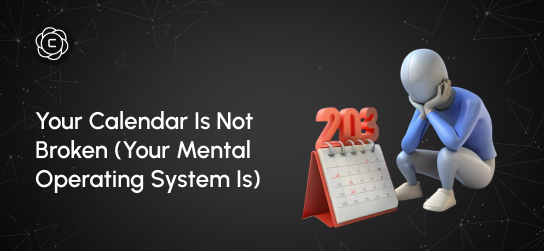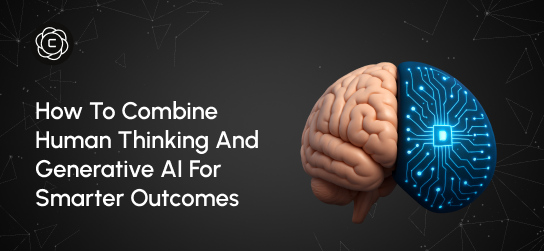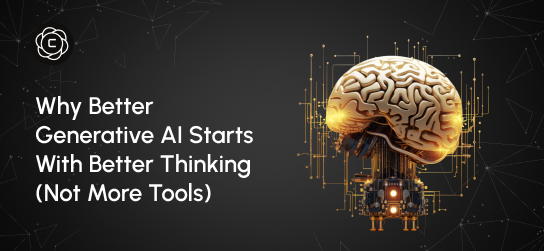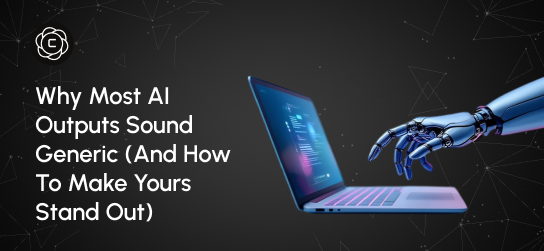Learning Center
Master AI creativity with our comprehensive guides, tutorials, and expert insights. From beginner basics to advanced techniques.
The AI Ghostwriter That Speaks Your Voice (No Prompt Engineering Required)

Introduction
Last Tuesday, my client Eva received three separate compliments on her most recent blog post. The funny part? She didn’t type a single word but every line still carried her voice. The entire piece was drafted by an AI ghostwriter that mimicked her voice so precisely, long-time readers assumed she had finally hit her stride as a content creator.
This wasn’t a magic hack or some clever prompt-engineering sleight of hand. It was simply the result of her feeding past writing samples into a smart system, one that quickly learned her patterns, preferences, and tone. Within two weeks, Eva had an AI assistant that understood her writing style better than most human collaborators ever could.
The breakthrough here isn’t the technology, it’s the accessibility. Voice replication is no longer reserved for tech elites or professional copywriters. It’s now within reach for everyday professionals who need consistent, high-quality content but lack the time or confidence to write it themselves.
Why Traditional AI Writing Feels Robotic
For most people, their first experience with AI-generated content feels underwhelming. The writing might be technically correct and grammatically sound but it comes across as sterile, detached, and oddly impersonal. It sounds more like it was written by a corporate committee than a real person with something meaningful to say.
That’s because standard AI models are trained on enormous datasets that represent every style, every voice, and every tone. So when they generate content, they default to what’s statistically average. In trying to appeal to everyone, they end up sounding like no one in particular.
Here’s what usually goes wrong:
-
Generic Voice Syndrome: When AI aims for universal appeal, it loses all sense of identity. The result is writing that’s clean but flat, technically polished, but emotionally lifeless.
-
Context Confusion: Without a clear understanding of your audience, your industry, or your communication goals, AI struggles to land the right tone. The content might be accurate, but it misses the mark on nuance and relevance.
-
Personality Vacuum: Most AI writing lacks the little quirks and preferences that make human expression relatable. It doesn’t share your opinions, it doesn’t know your humor, and it doesn’t reveal your unique perspective.
-
Inconsistent Messaging: Every AI session starts fresh. Unless trained on your past material, it forgets your voice, tone, and messaging principles with every prompt.
This is why so many professionals walk away frustrated. They don’t want content that just sounds correct, they want content that sounds like them.
The Voice Recognition Revolution
Today’s AI systems have taken a major leap forward. With the right inputs, they can learn the subtle intricacies of how you write; down to sentence rhythm, word choice, pacing, and even argument structure. They don’t just copy your words; they internalize your communication patterns.
Think of it like training a musician to play in your style. At first, they might get the notes right but miss your timing or energy. But the more they observe and practice, the more naturally they begin to anticipate your flow, your feel, your emotional tone. The result isn’t mimicry, it’s resonance.
Here’s how modern AI achieves this level of voice alignment:
-
Pattern Recognition: The system identifies how you open thoughts, transition between ideas, and wrap up your arguments. It builds a fingerprint of your communication logic.
-
Tone Calibration: It adapts to your emotional baseline, whether you tend to be bold or nuanced, relaxed or authoritative, optimistic or skeptical.
-
Vocabulary Mapping: Over time, it learns which words you reach for and which ones you never use. It customizes phrasing to reflect your natural language habits.
-
Structural Preferences: Whether you prefer long flowing paragraphs, sharp bullets, or a hybrid of both, smart AI tools replicate your formatting tendencies.
The goal isn’t to replace your voice or creativity, it’s to scale it.
With the right system, you can create content at the pace of a professional team without sacrificing the authenticity that makes your message matter.
The Three Pillars of Authentic Voice Replication
Pillar 1: Voice Pattern Analysis
Your writing style isn’t just a matter of tone, it’s the result of thousands of small, subconscious decisions. From how you open a sentence to the metaphors you lean on, from paragraph length to punctuation rhythm, all of it forms a fingerprint that makes your writing unmistakably yours.
Tools like Crompt’s Content Writer make it possible to surface those patterns without you having to define them manually. Most people struggle to describe their own voice but the truth is, you don’t need to. You’ve already written it. The AI just needs to analyze and learn from what’s already there.
Your authentic voice already lives inside past blog posts, emails, social media captions, and even internal reports. AI doesn’t invent it. It simply extracts the patterns and brings them to life, again and again with accuracy.
Pillar 2: Contextual Adaptation
Your voice isn’t one-dimensional. You shift your tone based on who you’re speaking to, where it’s shared, and what it’s meant to do. A client-facing proposal has a different tone than a public-facing LinkedIn post. An internal Slack message reads nothing like a newsletter article.Smart AI systems recognize these differences. They don’t just replicate a voice, they replicate your voice across contexts. They understand that your confident strategist tone differs from your approachable teacher tone, even though both belong to you.
This dynamic adaptability is what prevents AI writing from sounding robotic. It keeps your messaging consistent, but never stiff or repetitive. And that’s what makes it feel human.
Pillar 3: Continuous Refinement
A great AI ghostwriter doesn’t stay static, it evolves with your feedback. The more you edit, approve, and fine-tune, the better it becomes at capturing your preferences with precision.Crompt’s Grammar and Proofread Checker supports this process by analyzing how you edit AI-generated content. Over time, these subtle data points feed back into the system, sharpening the voice model with every round of collaboration.
This feedback loop isn’t just about grammar, it’s about style, tone, structure, and intent. The system learns what you accept, what you tweak, and what you reject, until it feels like an extension of your thinking.
Building Your Personal AI Ghostwriter
Step 1: Gather Voice Samples
Start by collecting 10–15 of your strongest writing samples. Pull from a range of sources; blog posts, emails, social media updates, reports, or any content where your voice feels most alive.
Don’t just reach for what’s recent. Choose pieces that feel like you on your best day. These samples form the foundation of your ghostwriter’s identity.
Step 2: Train the Pattern
Feed those samples into an AI platform capable of voice analysis. Tools like Crompt’s Improve Text can detect your signature patterns; sentence flow, transition habits, vocabulary choices, and structural tendencies.This becomes the DNA of your voice model. The more consistent and high-quality the input, the sharper the output.
Step 3: Test, Calibrate, Repeat
Start small. Use the voice model for lightweight content—think internal memos or social media posts. Generate a few variations, and pick the one that feels most natural. Tweak it. Approve it. Teach the AI how you make decisions.This testing phase isn’t just about getting content out. It’s about building trust in the system—and in your ability to steer it.
Step 4: Scale Your Output
Once the model reliably mirrors your voice, start applying it to higher-leverage content. Blog posts, client messaging, campaign copy, anything that benefits from tone consistency and brand clarity.
You still guide the final product, but the system does the heavy lifting. You maintain control while reducing the cognitive load of writing from scratch.
Advanced Voice Customization Techniques
Emotional Range Mapping
Your voice isn’t one mood, it’s a spectrum. The way you write when you're energized and excited feels completely different from how you write when you're reflective or analytical. Both styles are equally authentic, but they communicate very different emotional tones.
To capture this range, train your AI using content created in various emotional states. Feed it writing from moments of passion, frustration, joy, or deep thought. The system will begin to learn when to dial up the enthusiasm—and when to hold back and speak with nuance.
Audience-Specific Variations
Your tone naturally shifts based on who you’re speaking to. When writing for industry veterans, you can lean into technical language, assume prior knowledge, and move quickly through the basics. But when addressing beginners, you need to slow down, explain context, and avoid jargon that might confuse or alienate.
It’s the same topic but two completely different conversations. And that difference isn’t trivial. It’s what determines whether your message lands or gets ignored.
To make your AI sound genuinely human, train it to recognize these audience segments. Build distinct voice profiles that reflect how you teach newcomers versus how you challenge seasoned experts.
Platform Optimization
Writing for Twitter is not the same as writing a report. Social media rewards brevity, rhythm, and punch. Long-form content demands depth, nuance, and flow.To match these needs, train your AI across multiple content formats. Build distinct models for short-form posts, email newsletters, thought leadership articles, and reports. Each one should reflect the platform’s expectations while preserving your signature tone.
Collaborative Voice Development
Voice refinement isn’t a solo act, it’s an ongoing collaboration between you, your audience, and your AI system. Tools like Crompt’s Business Report Generator can help you analyze which tone, structure, and phrasing styles perform best across different audiences.Once you identify what resonates most, feed those winning patterns back into your voice model. This creates a feedback loop that not only preserves authenticity but sharpens it over time.
The Quality Control Framework
Even the most advanced AI-generated content needs human guidance. Replicating your voice is one thing, ensuring it lands with clarity, accuracy, and strategic alignment is another. That’s where quality control becomes essential.
Content Review Protocol: Before publishing, always read AI-generated content out loud. The human ear picks up rhythm breaks, awkward phrasing, and tonal mismatches your eyes might skip. If it doesn’t sound like you, it’s not ready to go live.
Fact-Checking Integration: AI is brilliant at mimicking your tone but it can invent facts, misrepresent data, or pull outdated references. Always verify names, numbers, statistics, and claims. Voice without truth erodes trust.
Brand Alignment Check: Even if a piece sounds like you, it still needs to represent you. Make sure the content supports your brand narrative, reinforces your values, and aligns with your strategic positioning. Voice replication without brand alignment is just noise.
Audience Feedback Monitoring: Pay attention to how your audience responds. Do AI-assisted posts generate more engagement, or less? Are people commenting, sharing, responding or staying silent? Let those signals guide your voice calibration. Over time, your AI should evolve alongside your readers’ preferences.
Scaling Authentic Communication
The true power of AI ghostwriting doesn’t just show up in isolated content, it reveals itself when you're trying to maintain consistent voice across multiple channels at once. Your blog, your email newsletter, your social media presence, and your client messages all require your voice. But they also demand vastly different levels of time, energy, and creative bandwidth.
With a properly trained AI system, you no longer have to choose between scale and authenticity. You can stay personally connected to your audience while dramatically increasing your content output. Your voice shows up everywhere without burning you out in the process.
Crompt’s Email Assistant is a perfect example of how this scaling works. It maintains your tone and communication style across different email types, all while reducing writing time by over 70%. That’s not just automation, it’s liberation from the bottlenecks that slow down real connection.
The Trust Factor
One of the most common concerns people raise about AI ghostwriting is this:
"Won’t my audience notice?”
"Isn’t this dishonest?”
These are fair questions but they often miss the deeper truth.
AI that is carefully trained to replicate your voice is actually more authentic than hiring a freelance writer who doesn’t fully understand your point of view or audience. It’s not about replacing your voice, it’s about making sure your voice shows up everywhere it needs to.
Your insights, your stories, your strategies, they all remain 100% yours. The AI simply removes the mechanical friction of writing, so your message comes through faster, clearer, and more consistently.
Beyond Personal Branding
This isn’t just a solo creator tool, it’s a strategic asset for entire organizations. When voice-trained AI systems are applied across teams, every employee becomes capable of writing in alignment with the company’s brand tone and messaging standards.
That means your marketing emails, support responses, executive updates, and internal docs all sound unified without sounding robotic. Brand trust is built through consistency, and this is how you scale it without hiring an army of editors.
AI doesn’t flatten your voice. It multiplies it. Across departments, across platforms, across time zones.
The New Standard of Professional Communication
The future isn’t about choosing between human depth and AI efficiency. It’s about combining the two to create a scalable communication system, one that keeps your message consistent, your tone personal, and your workload manageable.
Your voice is one of your strongest assets; it builds trust, creates clarity, and sets you apart. When captured and scaled through AI, it becomes a competitive advantage that works around the clock without compromising trust or authenticity.
If you're ready to build your own AI ghostwriter, start with Crompt AI. Discover how voice-trained systems can help you communicate with clarity, personality, and consistency at a scale that manual writing simply can’t match.
Want to take your strategy further? Explore our advanced guide: How to Train AI to Write Like You (Without Any Prompt Hacks). It’s the next step in turning your writing style into a scalable, high-impact system.
Table of Content
- Introduction
- Why Traditional AI Writing Feels Robotic
- The Voice Recognition Revolution
- The Three Pillars of Authentic Voice Replication
- Building Your Personal AI Ghostwriter
- Advanced Voice Customization Techniques
- The Quality Control Framework
- Scaling Authentic Communication
- The Trust Factor
- Beyond Personal Branding
- The New Standard of Professional Communication

Your Calendar Is Not Broken (Your Mental Operating System Is)
Last month, I watched a founder spend three hours reorganizing his calendar app for the fourth time this year. Different colors, new categories, smarter blocking strategies. By week two, he was back to the same chaotic pattern: overcommitted, constantly running late, and feeling like his day controlled him instead of the other way around. The problem wasn't his calendar. It was the mental operating system running underneath it. Calendar issues aren’t about tools; they’re about how you think about time. They download new apps, try productivity methods, and wonder why nothing sticks. Meanwhile, the real issue sits in how their brain processes time, priorities, and commitments.

How to Combine Human Thinking and Generative AI for Smarter Outcomes
Last Tuesday, I watched two product managers go head-to-head on the same challenge. Same tools. Same data. Same deadline. But the way they used AI couldn’t have been more different and the results made that difference unmistakable. One delivered a generic solution, familiar and easily replicated. The other crafted a proposal that felt thoughtful, grounded, and strategically distinct. Their CEO approved it for implementation within minutes. The gap wasn’t technical skill or AI proficiency. It was their thinking architecture, the way they framed the problem, used AI to explore, and layered in human context to guide the output.

Why Better Generative AI Starts With Better Thinking (Not More Tools)
Four months ago, I watched a marketing director spend $400 on AI subscriptions only to produce the same mediocre content she'd always created. Her problem wasn't the tools. It was her approach. This scenario plays out everywhere. Professionals accumulate AI subscriptions like digital trophies, believing more tools equal better results. They're missing the fundamental truth: generative AI amplifies your thinking, not replaces it. The best AI users I know don't have the most tools. They have the clearest thinking processes.
Stay Updated
Get the latest AI insights, tutorials, and feature updates delivered to your inbox.






